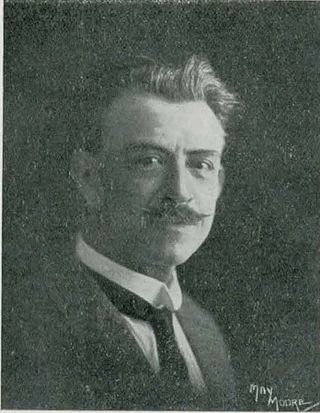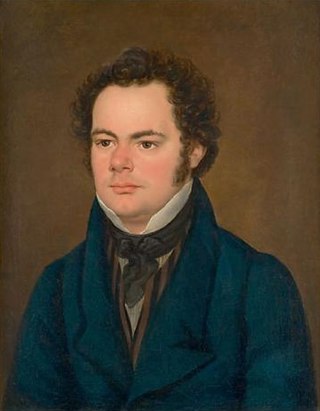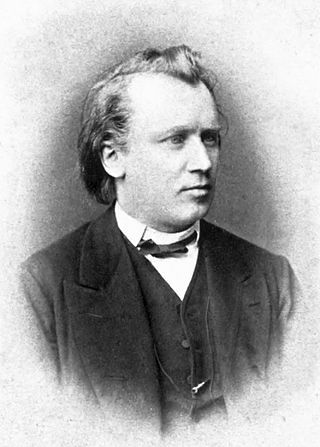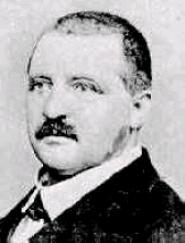Related Research Articles
Cyclic form is a technique of musical construction, involving multiple sections or movements, in which a theme, melody, or thematic material occurs in more than one movement as a unifying device. Sometimes a theme may occur at the beginning and end ; other times a theme occurs in a different guise in every part.
The String Quartet No. 2 is a string quartet in D major written by Alexander Borodin in 1881. It was dedicated to his wife Ekaterina Protopova. Some scholars, such as Borodin's biographer Serge Dianin, suggest that the quartet was a 20th anniversary gift and that it has a program evoking the couple's first meeting in Heidelberg. Of its four movements, the third movement "Notturno" is the most famous.

Alfred Francis Hill CMG OBE was an Australian-New Zealand composer, conductor and teacher.

The String Quartet No. 12 in F major, Op. 96, nicknamed the American Quartet, is the 12th string quartet composed by Antonín Dvořák. It was written in 1893, during Dvořák's time in the United States. The quartet is one of the most popular in the chamber music repertoire.

Franz Schubert's final chamber work, the String Quintet in C major is sometimes called the "Cello Quintet" because it is scored for a standard string quartet plus an extra cello instead of the extra viola which is more usual in conventional string quintets. It was composed in 1828 and completed just two months before the composer's death. The first public performance of the piece did not occur until 1850, and publication occurred three years later in 1853. Schubert's only full-fledged string quintet, it has been praised as "sublime" or "extraordinary" and as possessing "bottomless pathos," and is generally regarded as Schubert's finest chamber work as well as one of the greatest compositions in all chamber music.

Ludwig van Beethoven's String Quartet No. 10 in E-flat major, Op. 74, was written in 1809 and is nicknamed the "Harp" quartet.

The Piano Quartet No. 3 in C minor, Op. 60, completed by Johannes Brahms in 1875, is scored for piano, violin, viola and cello. It is sometimes called the Werther Quartet after Goethe's The Sorrows of Young Werther. The premiere took place in Vienna on November 18, 1875, to an anxious public. Richard Wagner and his wife Cosima were in attendance.

Anton Bruckner's String Quintet in F major, WAB 112 was composed in 1878/79 in Vienna.
Jean François Toussaint Rogister was a Belgian virtuoso violist, teacher and composer.
The String Quartet in D major is the only string quartet composed by César Franck. The work was written from 1889 to 1890.
String Quartet No. 1 in B-flat major "Maori Quartet", Stiles 1.2.3.3 SQ1 is the first of Alfred Hill's seventeen string quartets. Its composition began before 1892, it was completed after 1896 and premiered only on 18 May 1911 in Sydney.
String Quartet No. 2 in G minor "A Maori Legend in Four Scenes", Stiles 1.2.3.3 SQ2, often called "Maori Quartet", was composed by Alfred Hill in 1907–1911 and premiered immediately in 1911. It is dedicated to Earnest [sic] Wunderlich — "in slight appreciation". The first two quartets were published together by Breitkopf & Härtel in 1913. Each of them used to be referred as Maori, a feature that can lead to confusion. Today the first one is called Maori, while for the second the longer subtitle is retained.
Symphony No. 1 in B-flat major, Stiles 1.3.4.1 Sy1, the so-called Maori Symphony, is the first symphony by Alfred Hill. Its first three movements were completed by 1898, but the last movement remained unfinished. This may have been the second symphony composed in the Antipodes. The first two movements of this symphony are the only symphonic movements by Hill not to be arranged from his earlier chamber music. The Finale was reconstructed by Allan Stiles, and the whole symphony got its first performance in 2007. The approximate duration is 40 minutes.
String Quartet No. 4 in C minor, Stiles 1.2.3.3 SQ4, was completed by Alfred Hill on 25 July 1916 in Neutral Bay, Sydney. It is dedicated to Henri Verbrugghen and his Verbrugghen String Quartet. It is Hill's first non-program string quartet. The first two movements were transcribed for orchestra in 1955 forming the basis of the Symphony No. 4 "The Pursuit of Happiness" in which this music turns to have a program.
Symphony No. 4 in C minor "The Pursuit of Happiness", Stiles 1.3.4.1 SyP, was finished by Alfred Hill in 1954 or 1955. Its first two movements were arranged from Hill's String Quartet No. 4 (1916), while the last one derives from the finale of his String Quartet No. 17. The symphony is dedicated "to my esteemed friend Henry Kripps", a prominent Australian conductor. Its approximate duration is 20 minutes.
String Quartet No. 5 in E-flat major "The Allies", Stiles 1.2.3.3 SQ5, was completed by Alfred Hill on 24 June 1920 in Sydney. It is dedicated to Henri Verbrugghen, whose quartet gave the first public performance of the composition on 2 March 1921. The music of the quartet presents four nations who were allies during World War I. It was subsequently arranged by Hill for string orchestra as his Symphony No. 11 "The Four Nations". The approximate duration of the quartet is 29–33 minutes, which makes it one of the most substantial quartets composed by Hill.
Symphony No. 11 in E-flat major "The Four Nations" for string orchestra, Stiles 1.3.3.1 SyFN, was arranged by Australian composer Alfred Hill from his String Quartet No. 5 "The Allies" at some point in 1950s, but the precise date remains unknown, and there is no information about the first performance. The music of the symphony follows that of the original String Quartet, except for the Finale being 4 bars shorter than in the quartet, due to a minor truncation of the melody of the main subject at each repeat of it. The most obvious difference is the addition of the double bass part. Hill also altered the title of the composition.
String Quartet No. 6 in G major "The Kids", Stiles 1.2.3.3 SQ6, by Alfred Hill bears dedication: "for the young fry at the New South Wales State Conservatorium of Music". It was most likely written for the student string quartet groups at the Conservatorium mentored by the composer. The manuscript is dated 3 September 1927. Its technical demands being limited, it is an accessible for amateurs composition. The quartet is set in earlier style, reminiscent of Haydn, Schubert, and other classical composers. With approximate duration of only 15–16 minutes, this is the shortest of all Hill's quartets.
String Quartet No. 7 in A major, Stiles 1.2.3.3 SQ7, by Australian composer Alfred Hill was commenced in Melbourne and finished in Sydney on 18 November 1934, as stated in the manuscript score preserved in the National Library of Australia. It is thought to be the last of Hill's middle period quartets, with some impressionistic features being transitional to his later compositions. Approximate duration is 20,5 minutes.
String Quartet No. 8 in A major, Stiles 1.2.3.3 SQ8, by Australian composer Alfred Hill was finished half month after his Seventh: the manuscript score and parts, which are preserved in the National Library of Australia, are dated 6 December 1934. While the previous quartet was a somewhat transitive composition from his middle period, with the Eighths one starts counting Hill's late quartets. It is thematically unified and has many impressionistic features. In 1950s Hill arranged it into a string symphony, the first known performance of which was on 27 March 1957. The approximate duration of the quartet is 25–28 minutes.
References
- 1 2 3 4 5 6 Allan Stiles. A Catalogue of the Music of Alfred Hill
- ↑ Donald Maurice. Booklet notes to Naxos 8.570491
- 1 2 3 Keith Anderson. Booklet notes to Naxos 8.223538
- 1 2 3 4 5 6 7 Catalogue entrance in the National Library of Australia
- ↑ Rhoderick McNeill (23 March 2016). The Australian Symphony from Federation to 1960. Routledge. pp. 99–. ISBN 978-1-317-04087-3.
- 1 2 3 4 5 "HILL, Alfred: String Quartets, Vol. 1 (Dominion String Quartet) - Nos. 1, 2, 3".
- 1 2 3 Thomson, John Mansfield (1993). "Hill, Alfred Francis". Te Ara - the Encyclopedia of New Zealand.
- 1 2 Lam, Y. C. (2006, June). Analytical study of Alfred Hill’s String Quartet no. 2 in G minor (Thesis, Master of Arts). University of Otago. Retrieved from http://hdl.handle.net/10523/128
- 1 2 Rogers, Melissa; Mora, Manolete (2018). Revisiting Alfred Hill (1869–1960): Examining Issues of Reception and Compositional Approach. University of New South Wales. Arts and Media. OCLC 1089650042.
- ↑ Thomson, J.M. (1970). ""The Role of the Pioneer Composer: Some Reflections on Alfred Hill, 1870–1960"". Studies in Music. 4: 52–61.
- ↑ "HILL: Symphonies Nos. 5 and 10".
- 1 2 3 4 "Alfred Hill - String Quartet No.3". www.stilesmusicpublications.com. Retrieved 2022-04-13.
- 1 2 3 4 5 6 7 8 9 10 Rogers, Melissa; Mora, Manolete (2018). Revisiting Alfred Hill (1869–1960): Examining Issues of Reception and Compositional Approach. University of New South Wales. Arts and Media. OCLC 1089650042.
- 1 2 "The composers and their work". Canberra: Australian Government Publishing Service. 1969.
- ↑ Rogers, Melissa; Mora, Manolete (2018). Revisiting Alfred Hill (1869–1960): Examining Issues of Reception and Compositional Approach. University of New South Wales. Arts and Media. OCLC 1089650042.